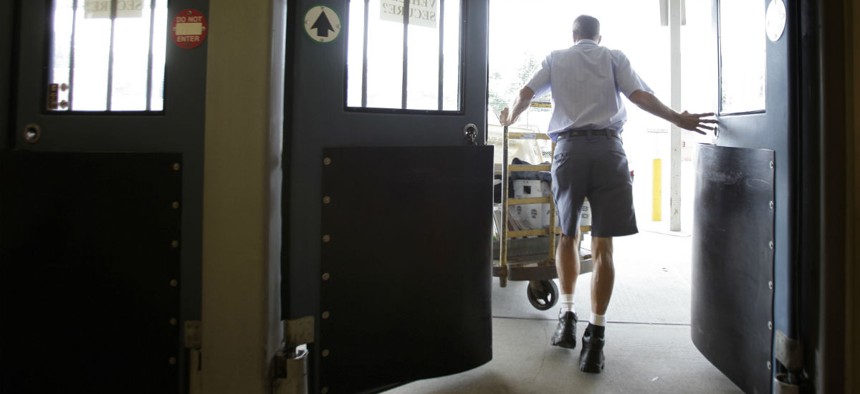Beyond Rain and Snow, Postal Workers Must Also Worry About Their Shoes
Letter carriers must wear footwear pre-approved by the U.S. Postal Service or face fines.
For years the U.S. Postal Service has put its stamp of approval on defective shoes that can quickly fall apart, putting letter carriers at risk of injury and often forcing them to pay for costly replacements out of their own pockets, union officials say.
The issue came to light after a study conducted by the National Institute for Occupational Safety and Health revealed that the soles of shoes worn by letter carriers in the Boston area frequently disintegrated. The agency detailed the health hazards caused by the faulty footwear in a letter to the Postal Service in February.
If polyurethane-soled shoes aren’t worn soon after coming off the assembly line, leftover moisture from the manufacturing process can expand and create microscopic cracks in the soles, Judith Eisenberg, a medical officer at NIOSH, wrote in the letter. The cracks can grow over time and eventually become large enough to separate the sole from the shoe and get caught on stairs and pavement.
She cited one 2004 incident where a letter carrier in Boston severely injured his back after the sole of his shoe split and caught on metal grating, causing him to fall down a flight of stairs.
The NIOSH study examined 143 accident reports for slips, trips and falls filed between 2011 and 2015 at the three largest post offices in the Boston area and found seven incidents where carriers specifically mentioned footwear. However, because USPS has no formal classification for shoe-related accidents, many may go unreported.
USPS has final say over most of its letter carriers’ wardrobes, including shoes, which must carry a green tag denoting the agency’s stamp of approval. Employees may be fined if they’re caught wearing non-sanctioned clothing.
To earn the green tag, shoes must be slip-resistant, built with water-resistant black leather uppers and waterproof lining, and go through independent testing at the U.S. Navy Clothing and Textile Research Facility, said Douglas Tulino, USPS vice president of labor relations. Certified footwear gets reevaluated every three years to ensure it meets industry standards.
While defective footwear may account for a relatively small proportion of accidents, wearing low-quality shoes can take a toll on letter carriers’ bodies over time, said Bobby Damatin, the safety representative for the National Association of Letter Carriers Branch 34.
“I want to be able to purchase [shoes] and be assured that the green tag means something,” Damatin said. “It means they’re quality and they’re safe and they’re going to prolong the health of my foot.”
A 31-year postal service veteran, Damatin compares letter carriers’ shoes to a car’s tires. In a job that keeps people on their feet for eight hours a day or more, good shoes can prolong a career, just as a bad ones can cut it short.
“If the tires are no good they’re ultimately going to damage the person,” he said. “It’s not a race, it’s a marathon. You need to be able to last in this job.”
With most approved shoes priced at more than $100 a pair, the costs of replacing faulty footwear can quickly add up. USPS provides letter carriers with an annual stipend of $400 for uniform expenses, but Damatin said that’s not enough to keep safe, agency-approved shoes on their feet. He estimates that newly purchased shoes last roughly three months on average before they start noticeably deteriorating.
Purchasing three to four new pairs of shoes every year quickly eats up a carrier’s stipend, which is meant to also cover shirts, pants, jackets and other clothing. As a result many carriers must wear unsafe shoes or shell out their own money for new footwear.
Damatin said low-quality shoes have been a problem during his entire tenure as a letter carrier. The first time he presented the problem to administrators at the Boston USPS office in October 2015, they referred him to a separate agency, which in turn referred him to NIOSH, he said.
In her letter, Eisenberg recommended that USPS clarify the certification process and more clearly identify and report shoe-related accidents.
She also suggested conducting a nationwide review of accident reports to see if the sole deterioration problem extends beyond the Boston area to all letter carriers wearing the green tag shoes.
“I wouldn’t be surprised if this was a wider issue,” she said. “The first step is raising awareness.”
NEXT STORY: Eavesdropping Actually Makes Us Better People




